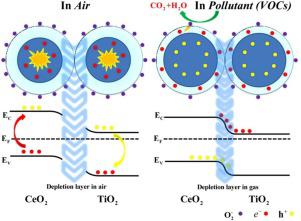Sensors and Actuators A: Physical ( IF 4.1 ) Pub Date : 2020-07-25 , DOI: 10.1016/j.sna.2020.112226 Seyed Amirabbas Zakaria , Susan Samadi , Ghasem Asadi Cordshooli

|
The core/shell nanostructures were successfully synthesized by sol-gel assisted hydrothermal method and doped by and ions. Different characterization experiments used to identify particles morphology and microstructures to confirm the formation of desired core/shell structure. The produced materials were used to make gas sensors for volatile organic compounds. Doping the core/shell structure by 1% molar ratios of zirconium (IV) and vanadium (III) increased its sensitivity from 26.50 to 277.50 with respect to 420 ppm ethanol at room temperature (29 °C, 45 % RH). Linear dependence of the sensitivity logarithm to the concentration of volatile organic compounds with reasonably low relative standard deviation (%RSD) suggests that the sensors can be used for quantitative and qualitative measurements. Long time measurements of the sensitivity revealed that the sensors output are temporally stable up to 11 months. The sensitivity mechanism is explained based on the depletion region created in the hetero-junction of semiconductor materials.
中文翻译:

掺杂锆(IV)和钒(III)的合成与表征 核/壳纳米结构作为气体传感器
的 溶胶-凝胶辅助水热法成功合成了核/壳纳米结构并掺杂 和 离子。用于鉴定颗粒形态和微观结构以确认所需核/壳结构形成的不同表征实验。所生产的材料用于制造用于挥发性有机化合物的气体传感器。在室温(29°C,45%RH)下,相对于420 ppm乙醇,以1%的锆(IV)和钒(III)摩尔比掺杂核/壳结构,其灵敏度从26.50增加到277.50。灵敏度对数与挥发性有机化合物浓度的线性相关性具有相对较低的相对标准偏差(%RSD),表明该传感器可用于定量和定性测量。长时间的灵敏度测量表明,传感器的输出在长达11个月的时间上都是稳定的。











































 京公网安备 11010802027423号
京公网安备 11010802027423号